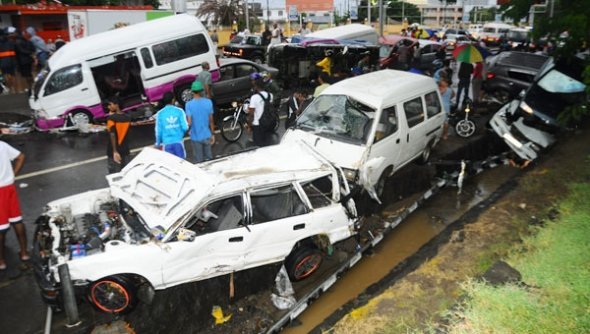How To Avoid Buying a Flood-Damaged Car

But full elimination of consequences of drowning is impossible. To eliminate all of the consequences of «drowned car» you'll need to disassemble the whole car till the last nut, dry it well, clean, grease and assemble it. It is not difficult to realize that such operations cost will be comparable to the price of the new car.
At the same time, some tags of drowned car can be easily found out. For example some of the power outages can be the sign of a “wet-car”: the onboard computer, the accumulator, the central lock, car-blinkers, electro adjustments of armchairs etc. can work incorrectly. Also look for some damages in heater. After water influenced the car the leather on armchairs hardens, and a rust can appear on some of metal parts of your car.
Smudges can appear on the leather-part of your doors, and on the interior plastic parts, under the floor upholstery and under the rubber seals of windows moisture can be detected. Traces of water may also be presented in the headlamps (smudges appears) and rear lights (condensate appears). From water influence optics reflectors grow turbid, the instrument panel from the inside mists over. And, of course, “drowning” can negatively affect main-engine work what appears in its rough work on idling and during test runs.
In addition, here are some flood-spotting tips from the US National Automobile Dealers Association that will minimize the risk to used-car buyers:
1. Be alert to unusual odors. Musty or moldy odors inside the car are a sign of mildew buildup from prolonged exposure to water. It might be coming from an area the seller is unable to completely clean. Beware of a strong air freshener or cleaning solution scent, as it may indicate the seller is trying to cover up something. Run the air-conditioner to see if a moldy smell comes from the vents.
2. Look for discolored carpeting. Large stains or differences in color between lower and upper upholstery sections may indicate that standing water was in the vehicle. A used car with brand-new upholstery is also a warning sign, as a seller may have tried to remove the flood-damaged upholstery altogether.
3. Examine the exterior for water buildup. This may include fogging inside headlamps or taillights and damp or muddy areas where water naturally pools, such as overhangs inside the wheelwell. A water line might be noticeable in the engine compartment or the trunk to show that the car sat in standing water.
4. Inspect the undercarriage. Look for evidence of rust and flaking metal that would not normally be associated with late-model vehicles.
5. Be suspicious of dirt buildup in unusual areas. These include areas such as around the seat tracks or the upper carpeting under the glove compartment. Have an independent mechanic look for caked mud or grit in alternator crevices, behind wiring harnesses and around the small recesses of starter motors, power steering pumps and relays.
Related News


